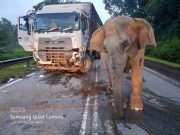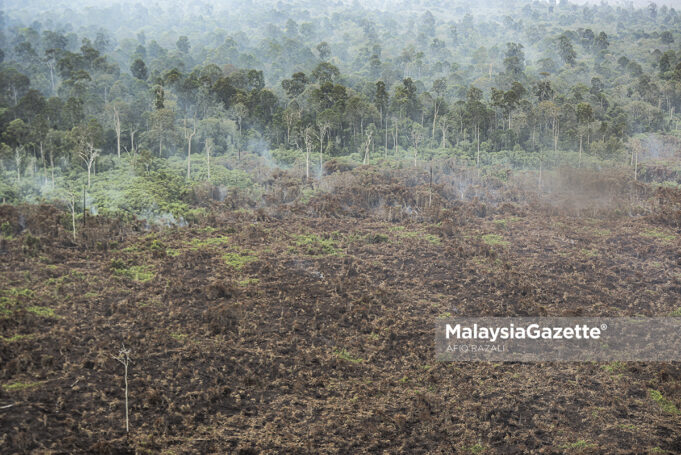The following article is submitted to the Editor of MalaysiaGazette by Muhammad Zakwan Bin Hassan Nudin, a student in Faculty of Medicine & Health Sciences from Universiti Sains Islam Malaysia (USIM).
While there is a sharp increase in people’s concern about the global COVID-19 crisis and economic recession, climate change is still seen by some researchers as the most pressing issue that mankind faces. The vast introduction of technology to the majority of the population around the globe has brought about a shift in terms of interconnectivity and human productivity. As there are always two sides of a coin, these modernizations also account for a remarkable increase in acidic gases emission such as carbon dioxide to the atmosphere, which subsequently results in the greenhouse effect. The question is, to what extent the severity of today’s global warming compared to the previous era
According to an official statement from NASA on 14th January 2021, year 2020 was ranked to be the warmest on the record, tying with the global surface temperature in 2016 with 50% increment in atmospheric carbon dioxide level since Industrial Revolution 250 years ago. This is further proven by the catastrophic 2020 wildfire outbreaks that took place in California, USA & Kangaroo Island, Australia which were recorded to be among the worst wildfire disasters in modern history. The wildfire itself may not be ignited primarily by the climate change, however, it is worth knowing the fact that the global warming itself increases the risk and exacerbates this unfortunate events.
So, why is it considered the worst threat to the planet? To begin with, climate change in today’s world will endanger some of the pre-existing animal species on earth. When we talk about climate change, it is frequently articulated with the unintentional increase in global temperature due to the nature of carbon dioxide itself that traps heat. The rising global temperature not only can produce heat wave, but it also endangers the arctic regions which
have becoming a powerful habitat for some species such as penguins, polar bears, and seals. These regions are very vulnerable to heat and when they are exposed to the rising global
temperature, the ice in which they contain tends to melt and therefore destroys the natural habitat for these species. To give a clearer illustration, a heart-wrenching photo that was circulating in early 2021 depicts a starved and skinny polar bear, which is probably due to the fact that the habitat of this polar bear is deteriorated thus making it difficult for the bear to fetch for foods within the interrupted ecosystem. Note that a polar bear consumes meat as its primary dietary meal in order to sustain its survivability, which mostly comes from seals that have surfaced within the holes of the ice sheets. So, when the ice is melted, there will be no seals and thus reduce the source of meal for the bear, thus threaten its survivability.
Besides, the shift in the earth’s climate also promotes the probability for natural disasters to occur. As mentioned earlier, the heat retention resulted from climate change will lead to melting of the ice sheets of the arctics. Hence, when the ice is melted, the excess liquid produced will flow to the Antarctic ocean and thus rises the sea level. This is very alarming especially for a country that is vulnerable to high-sea level such as Maldives which was
estimated by the scientists to be underwater in the future if human activities contributing towards global warming is not terminated. Apart from that, the rising level of the ocean will
also promote and exacerbate the natural form of hurricanes and floods. For instance, a flood that is caused by normal seasonal migration will tend to be increased in depth as a result of an
increase in the sea water level. Another example that we can appreciate is the 2020 Kangaroo Island bushfire in Australia which was initially sparked by lightning strike and then exacerbated
by the rising temperature and serious heat wave, making the localised bushfire into an outbreak. Therefore, it is crystal clear that climate change not only threatens the humankinds, but it also threatens our natural environment by aggravating the pre-existing form of natural disasters.
Apart from that, the normal seasonal cycle will also be interrupted if the climate change proceeds from time to time. Due to the rise in acidic gases emission to the atmosphere, the resultant global warming and heatwave will induce the early termination of the winter season in western and eastern countries, thereby shortening the normal duration of this season compared to the previous age. As the winter season is shortened, global warming also induces the prolongation of heat-related seasons such as summer and spring, which will intersperse some of the pre-existing ecosystems that have been adapted for years. Due to abnormally warm weather in late winter, trees and spring wildflowers tend to bloom earlier than their typical timeline, leaving them vulnerable to any subsequent frost damage. This can significantly affect the fruits, nuts, or seeds production of the affected plants. Also, weather like rain and thunderstorm are estimated to occur more frequently from now and henceforward, which can potentially disturb the living cycle of animals and plants that have becoming the main source of meals for human beings. Thus, the damage caused by climate change to the nature and
human society can be mutually destructive. As expressed, it is crucial for us to acknowledge the importance of maintaining the normal cycle of seasons for our own survivability, which can be deteriorated by the pre-existing climate change.
To conclude, there are numerous amounts of evidence provided by scientists that prove to us about the reality of man-made climate change and its forthcoming consequences to the environment. It is important for us to educate not only ourselves but also to give exposure to the people around us about the importance of taking good care of our planet Earth, which is collectively considered as our home. Ultimately, the mentioned examples above already show the severity of today’s climate shift towards the animal species survivability and eventually ours. As a proverb says, don’t cry over the spilt milk, we can’t undo the damage we have done to the mother nature and earth but we can endorse ourselves to eliminate any activities contributing to global warming in order to persist the sustainability and preserve the beauty of this planet for upcoming generations.
Muhammad Zakwan Bin Hassan Nudin,
Student in Faculty of Medicine & Health Sciences,
Universiti Sains Islam Malaysia (USIM)

















